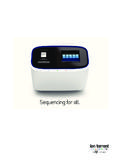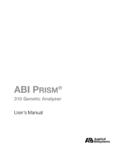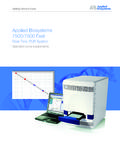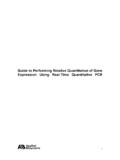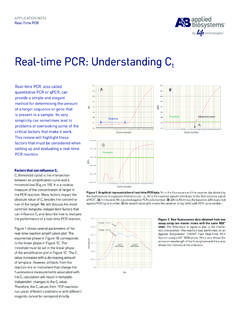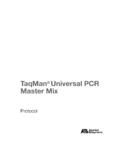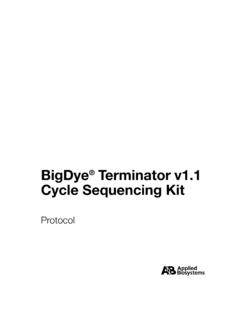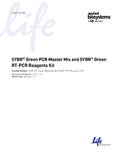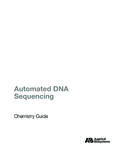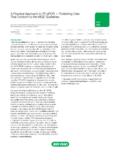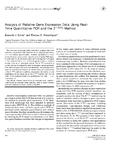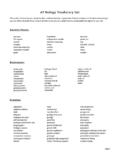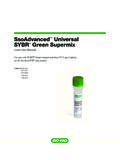Transcription of High Capacity cDNA Reverse Transcription Kits
1 high Capacity cDNA Reverse Transcription KitsFor 200 and 1000 ReactionsProtocol Copyright 2006, 2007, 2010 Applied Biosystems. All rights Research Use Only. Not for use in diagnostic in this document is subject to change without notice. Applied Biosystems assumes no responsibility for any errors that may appear in this BIOSYSTEMS DISCLAIMS ALL WARRANTIES WITH RESPECT TO THIS DOCUMENT, EXPRESSED OR IMPLIED, INCLUDING BUT NOT LIMITED TO THOSE OF MERCHANTABILITY OR FITNESS FOR A PARTICULAR PURPOSE. IN NO EVENT SHALL APPLIED BIOSYSTEMS BE LIABLE, WHETHER IN CONTRACT, TORT, WARRANTY, OR UNDER ANY STATUTE OR ON ANY OTHER BASIS FOR SPECIAL, INCIDENTAL, INDIRECT, PUNITIVE, MULTIPLE OR CONSEQUENTIAL DAMAGES IN CONNECTION WITH OR ARISING FROM THIS DOCUMENT, INCLUDING BUT NOT LIMITED TO THE USE OF LICENSE: No license is conveyed with the purchase of this product under Patents, and corresponding patent claims outside the , relating to the 5 nuclease and dsDNA-binding dye processes.
2 Further information on purchasing licenses may be obtained by contacting the Director of Licensing, Applied Biosystems, 850 Lincoln Centre Drive, Foster City, California 94404, :AB (Design), Applied Biosystems, and GeneAmp are registered trademarks and Applera, MicroAmp, and MultiScribe are trademarks of Applied Biosystems or its subsidiaries in the and/or certain other q M a n i s a r eg i s t e r e d t r a d e m a r k o f R o c h e M ol e c ul a r S y s t e m s, I n c .All other trademarks are the sole property of their respective Number 4375575 Rev. E06/2010iiiHigh Capacity cDNA Reverse Transcription kits ProtocolContentsFront MatterPreface .. vSafety .. vSafety Alert Words .. vChemical Hazard Warning .. vChemical Safety Guidelines .. viAbout MSDSs .. viObtaining MSDSs .. viChemical Waste Hazards .. viiChemical Waste Safety Guidelines .. viiiWaste Disposal .. viiiBiological Hazard Safety .. ixHow to Obtain Support.
3 XHigh Capacity cDNA Reverse Transcription kits Protocol . 1 Overview .. 1 Purpose of the high Capacity cDNA Reverse Transcription kits .. 1 Kit Features .. 1 Output Applications .. 1 About This Protocol .. 1 Good Laboratory Practices .. 2 PCR Good Laboratory Practices .. 2 Bibliography .. 2 Materials and Equipment .. 3 Kit Types .. 3 Kit Components .. 3 Kit Storage .. 3 Equipment Required but Not Supplied .. 4 Materials Required but Not Supplied .. 4 Using the high Capacity cDNA Reverse Transcription kits .. 6ivContentsHigh Capacity cDNA Reverse Transcription kits ProtocolOverview .. 6 RNA Template Guidelines .. 6 Input Amount of Total RNA .. 6 Preparing the 2 Reverse Transcription Master Mix .. 7 Preparing the cDNA Reverse Transcription Reactions .. 8 Performing Reverse Transcription .. 8 Storing cDNA Reverse Transcription Reactions .. 9 Appendix A, Examples of cDNA Yields from Reverse Transcription .. 11 Quantitative PCR.
4 11 Yields for Different Targets .. 11 Yield vs. Reaction Time .. 12 Index .. 15vHigh Capacity cDNA Reverse Transcription kits ProtocolPrefaceThis preface covers:Safety.. vHow to Obtain Support .. xSafetySafety AlertWordsFour safety alert words appear in Applied Biosystems user documentation at points in the document where you need to be aware of relevant hazards. Each alert word IMPORTANT, CAUTION, WARNING, DANGER implies a particular level of observation or action, as defined ! Indicates information that is necessary for proper instrument operation, accurate chemistry kit use, or safe use of a chemical. Indicates a potentially hazardous situation that, if not avoided, may result in minor or moderate injury. It may also be used to alert against unsafe practices. Indicates a potentially hazardous situation that, if not avoided, could result in death or serious injury. Indicates an imminently hazardous situation that, if not avoided, will result in death or serious injury.
5 This signal word is to be limited to the most extreme HazardWarningCHEMICAL HAZARD. Some of the chemicals used with Applied Biosystems instruments and protocols are potentially hazardous and can cause injury, illness, or Capacity cDNA Reverse Transcription kits ProtocolChemical SafetyGuidelinesTo minimize the hazards of chemicals: Read and understand the Material Safety Data Sheets (MSDSs) provided by the chemical manufacturer before you store, handle, or work with any chemicals or hazardous materials. (See About MSDSs on page vi.) Minimize contact with chemicals. Wear appropriate personal protective equipment when handling chemicals (for example, safety glasses, gloves, or protective clothing). For additional safety guidelines, consult the MSDS. Minimize the inhalation of chemicals. Do not leave chemical containers open. Use only with adequate ventilation (for example, fume hood). For additional safety guidelines, consult the MSDS. Check regularly for chemical leaks or spills.
6 If a leak or spill occurs, follow the manufacturer s cleanup procedures as recommended in the MSDS. Comply with all local, state/provincial, or national laws and regulations related to chemical storage, handling, and MSDSsChemical manufacturers supply current Material Safety Data Sheets (MSDSs) with shipments of hazardous chemicals to new customers. They also provide MSDSs with the first shipment of a hazardous chemical to a customer after an MSDS has been updated. MSDSs provide the safety information you need to store, handle, transport, and dispose of the chemicals time you receive a new MSDS packaged with a hazardous chemical, be sure to replace the appropriate MSDS in your MSDS for any chemical supplied by Applied Biosystems is available to you free 24 hours a day. To obtain MSDSs:1. Go to In the Search field of the MSDS Search page:a. Type in the chemical name, part number, or other information that you expect to appear in the MSDS of Select the language of your Click Capacity cDNA Reverse Transcription kits Protocol3.
7 To view, download, or print the document of interest:a. Right-click the document Select: Open To view the document Save Target As To download a PDF version of the document to a destination that you choose Print Target To print the document4. To have a copy of an MSDS sent by fax or e-mail, in the Search Results page:a. Select Fax or Email below the document Click RETRIEVE DOCUMENTS at the end of the document Enter the required Click View/Deliver Selected Documents :For the MSDSs of chemicals not distributed by Applied Biosystems, contact the chemical WasteHazardsHAZARDOUS WASTE. Refer to Material Safety Data Sheets and local regulations for handling and WASTE HAZARD. Wast es produced by Applied Biosystems instruments are potentially hazardous and can cause injury, illness, or STORAGE HAZARD. Never collect or store waste in a glass container because of the risk of breaking or shattering. Reagent and waste bottles can crack and leak.
8 Each waste bottle should be secured in a low-density polyethylene safety container with the cover fastened and the handles locked in the upright position. Wear appropriate eyewear, clothing, and gloves when handling reagent and waste Capacity cDNA Reverse Transcription kits ProtocolChemical WasteSafety GuidelinesTo minimize the hazards of chemical waste: Read and understand the Material Safety Data Sheets (MSDSs) provided by the manufacturers of the chemicals in the waste container before you store, handle, or dispose of chemical waste. Provide primary and secondary waste containers. (A primary waste container holds the immediate waste. A secondary container contains spills or leaks from the primary container. Both containers must be compatible with the waste material and meet federal, state, and local requirements for container storage.) Minimize contact with chemicals. Wear appropriate personal protective equipment when handling chemicals (for example, safety glasses, gloves, or protective clothing).
9 For additional safety guidelines, consult the MSDS. Minimize the inhalation of chemicals. Do not leave chemical containers open. Use only with adequate ventilation (for example, fume hood).For additional safety guidelines, consult the MSDS. Handle chemical wastes in a fume hood. After emptying the waste container, seal it with the cap provided. Dispose of the contents of the waste tray and waste bottle in accordance with good laboratory practices and local, state/provincial, or national environmental and health DisposalIf potentially hazardous waste is generated when you operate the instrument, you must: Characterize (by analysis if necessary) the waste generated by the particular applications, reagents, and substrates used in your laboratory. Ensure the health and safety of all personnel in your laboratory. Ensure that the instrument waste is stored, transferred, transported, and disposed of according to all local, state/provincial, and/or national !
10 Radioactive or biohazardous materials may require special handling, and disposal limitations may Capacity cDNA Reverse Transcription kits ProtocolBiological HazardSafetyBIOHAZARD. Biological samples such as tissues, body fluids, infectious agents, and blood of humans and other animals have the potential to transmit infectious diseases. Follow all applicable local, state/provincial, and/or national regulations. Wear appropriate protective equipment, which includes but is not limited to: protective eyewear, face shield, clothing/lab coat, and gloves. All work should be conducted in properly equipped facilities using the appropriate safety equipment (for example, physical containment devices). Individuals should be trained according to applicable regulatory and company/institution requirements before working with potentially infectious materials. Read and follow the applicable guidelines and/or regulatory requirements in the following: Department of Health and Human Services guidelines published in Biosafety in Microbiological and Biomedical Laboratories (stock no.)
